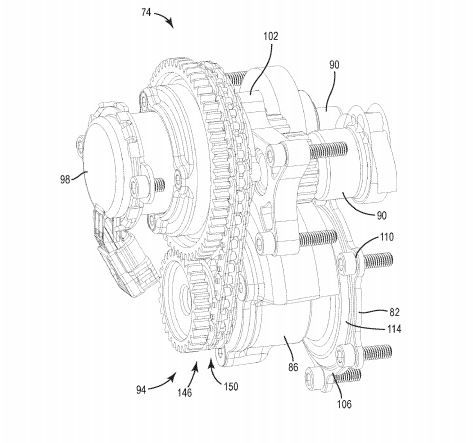Harley-Davidson file patents for VVT V-Twin
Harley-Davidson has filed patents showing a variable valve timing system that could power a new generation of bikes

HARLEY-DAVIDSON has filed a patent aimed at giving a new lease of life that could see the oldest bikes in the Harley’ range live on for another decade at least.
Harley-Davidson FXDR review
The patents show what looks like a conventional air-cooled V-twin engine that, on the face of it, looks fairly un-miraculous. On closer inspection, though we can see that the engine includes a clever Variable Valve Timing (VVT) system that could save some of the brand’s models from Euro5 extinction.

The operation of the VVT system is fairly complex, even more so thanks to the system being squeezed into a classically styled V-twin configuration. The heart of the operation is numbered as #74 in the diagram above. That mass of parts is the balance module. The crank is connected to the small gear (#154) which in turn rotates the gear above it (#158). On the back of that larger gear is a smaller toothed sprocket that turns the chain (#178) that in turn spins the balance weight (#86) in the opposite direction to the crankshaft. The VVT unit is numbered 98 and is connected to the cam gear, adjusting the timing of both the intake and exhaust valves.

While some VVT systems are lauded with boosting low, mid and top-end power and torque, the Harley-Davidson system is much more likely to be an act of self-preservation rather than adding more performance. The older an engine is, the more difficult it becomes to update the internals to meet the ever-tightening Euro emissions regulations. VVT is one of the simplest ways to get a power unit through the latest regs’ without massively increasing capacity of chucking on a turbo or supercharger!

What bikes could the new Harley-Davidson VVT system fit?
With a raft of new bikes in-coming from H-D, it likely that the unit we see in the patents will slot into an older model that’s at risk of being extinct in the coming years. The image of the engine in the patent shows a Fat Bob, although that is almost certainly a red-herring. The Fat Bob was updated recently and features a newly designed engine that will already have some years of generational development built into it. It’s more likely that the engine will form the basis of an updated range of classically styled Harley-Davidsons, possibly in the form of a new Sportster range in years to come.
.jpg?width=1600)

